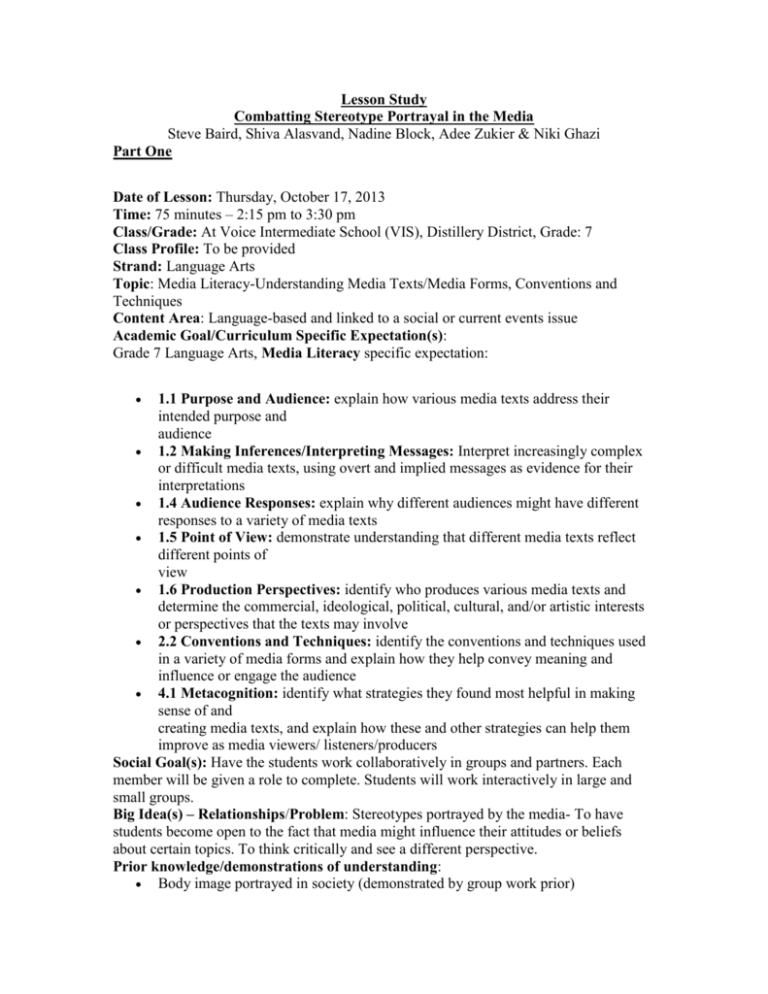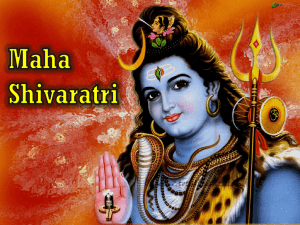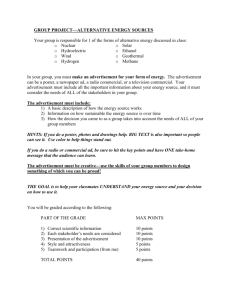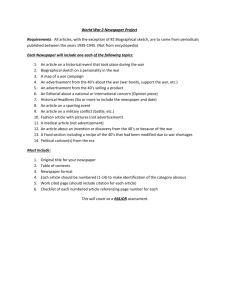File
advertisement

Lesson Study Combatting Stereotype Portrayal in the Media Steve Baird, Shiva Alasvand, Nadine Block, Adee Zukier & Niki Ghazi Part One Date of Lesson: Thursday, October 17, 2013 Time: 75 minutes – 2:15 pm to 3:30 pm Class/Grade: At Voice Intermediate School (VIS), Distillery District, Grade: 7 Class Profile: To be provided Strand: Language Arts Topic: Media Literacy-Understanding Media Texts/Media Forms, Conventions and Techniques Content Area: Language-based and linked to a social or current events issue Academic Goal/Curriculum Specific Expectation(s): Grade 7 Language Arts, Media Literacy specific expectation: 1.1 Purpose and Audience: explain how various media texts address their intended purpose and audience 1.2 Making Inferences/Interpreting Messages: Interpret increasingly complex or difficult media texts, using overt and implied messages as evidence for their interpretations 1.4 Audience Responses: explain why different audiences might have different responses to a variety of media texts 1.5 Point of View: demonstrate understanding that different media texts reflect different points of view 1.6 Production Perspectives: identify who produces various media texts and determine the commercial, ideological, political, cultural, and/or artistic interests or perspectives that the texts may involve 2.2 Conventions and Techniques: identify the conventions and techniques used in a variety of media forms and explain how they help convey meaning and influence or engage the audience 4.1 Metacognition: identify what strategies they found most helpful in making sense of and creating media texts, and explain how these and other strategies can help them improve as media viewers/ listeners/producers Social Goal(s): Have the students work collaboratively in groups and partners. Each member will be given a role to complete. Students will work interactively in large and small groups. Big Idea(s) – Relationships/Problem: Stereotypes portrayed by the media- To have students become open to the fact that media might influence their attitudes or beliefs about certain topics. To think critically and see a different perspective. Prior knowledge/demonstrations of understanding: Body image portrayed in society (demonstrated by group work prior) Acknowledging different forms of media (e.g. television, newspaper, advertisement) Able to analyze and explain particular images and text Assessment: 1. Observation throughout all aspects of the lesson 2. Student product 3. Student presentations/discussions 4. Ticket out the door Materials/Technology/Manipulatives available/needed: Placemats with corresponding pictures Advertisement example (video, image, text) for large and small group activities Ticket out the door Projector Part Two Team-Building Activity: Name Wave (3-5 mins) Using numbered- heads method, put students into groups. MINDS ON (Lesson Introduction/Mental Set/Sharing objectives/Sharing success criteria): Anti-Discrimination Activity (7-10 smins) o Shiva: I’m going to ask everyone to close their eyes (or if more comfortable look down at their desk) and try to imagine a series of scenarios: Imagine a family sitting around a table eating dinner Imagine two friends playing a game of basketball Imagine two people who are about to get married o Shiva: You can open your eyes now. I’m going to ask you a series of questions that I don’t want you to answer but just think about as I read them. When you imagined a family sitting around a table eating dinner, were they a white family? Or were they a family of colour? Was there a mom and a dad? Or two moms or two dads or was it a single- parent family? Were they sitting in a dining room of their house? When you imagined two friends playing basketball, were both friends boys or were they girls? Were both people able-bodied or were they in wheelchairs? When you imagined two people about to get married, were they a man and a woman? Or two men or two women? Were they getting married in a church? Or were they in a Mosque or a Synagogue or a different environment? o Steve: Why do you think that many of us hold a certain belief about the way things look or should be portrayed in society? When Shiva (Ms. Alasvand) asked you to imagine a family sitting around the dinner table, chances are each of you had a different mental image of what this would look like. Has anyone ever heard of the term metacognition before? (give students a chance to answer) Metacognition is the ability to think about your own thinking. What I’d like you to do now is to think about the factors that have led you to create the mental image in your head that you did when Shiva asked you these questions. I’d like you to turn to the person next to you (so in pairs or groups of 3) and discuss your thinking. What mental images did you imagine in your mind and what influenced you to create these images? (prompt students with an example if they are having trouble). Family and friends Schooling Media (TV, movies, commercials, advertisements, magazines, etc.) Placemat Activity (in stations) (5-7mins) o Students work in their table groups for this activity. o Each group has 2-3 minutes to do a placemat activity for a different topic expressed in the media Body Image/Abilities (SlimFast Advertisement) Culture/Race (Family dinner advertisement) Gender (Washing machine advertisement) o Each students completes a section of the placemat based on what they see in their advertisement (they write down their initial thoughts from looking at the images) o Discuss as a class some of the ideas that have been expressed on the placemats Goal of Lesson: Today we are going to look at stereotypes in the media. What do we mean when we talk about stereotypes? o Stereotype: A stereotype is used to categorize a group of people. People don't understand that type of person, so they put them into classifications, thinking that everyone who is that needs to be like that, or anyone who acts like their classifications is one. Today, we will analyze different forms of media and try to understand how they influence people’s attitudes and beliefs about certain topics. We are going to learn to be critical of the media we see ACTION! (20 mins) Shiva: Today we are going to talk about Media literacy. Let’s break down the concept. What does media mean to you? (make a concept map) o The means of communication, as radio and television, newspapers, and magazines, that reach or influence people widely: What does it mean to be literate? (make a concept map) o o Able to read and write. Understand how to read different types of text. Then we’ll put the two terms together as a class: o Media literacy is the understanding and ability to create, analyze and critique messages represented in different forms of media. o (Connect this back to the placemat activity and how the media can form our perspectives) Steve & Shiva - Show an advertisement (Dove Advertisement) with a subtle message (image projected on screen using PowerPoint) o Ask class to think, pair, share about what they just saw o Questions related to media literacy (Pre-written on chart paper) (Steve) 1. What Product is the advertisement for? (Shiva) 2. Who is the intended audience? (Steve) 3. What is the message sent to the reader? Is message obvious or subtle? (Shiva) 4. Describe how the manipulative choices of colours, words, types of pictures, and sizes of pictures support this unconscious message to the reader. (Steve) 5. Do you notice any examples of stereotypes? o Teacher facilitates entire class discussion about the advertisement and its messages Steve: Group work: Each group will be given an advertisement and will work to identify what the message is and how it may be recreating stereotypes about certain groups based on culture, race, gender, class, body imagine etc. Groups will be provided with a worksheet to guide them through their thought process. Explanation of Dove Ad: “Why is it racist. Although Dove denied the allegations, this is clearly a racist ad. The problem here is with the words before and after and with the alignment of the three women models. Think of it as a timeline. On the left, moment 0 we have an Afro-American woman, in the middle we have an Mulatto woman (the dove effect is clear), and on the right, there is a white woman.” CONSOLIDATION (10 mins) Shiva: Now that we know what is problematic with these ads, we want to know how we can change them in order to try and eliminate those stereotypes. Groups will have a few minutes to discuss what they would change and why they would change it. Students can write all over the picture to show what changes they would make. One student from each group presents their groups ideas and changes. Ticket out the door: 3, 2, 1 worksheet








